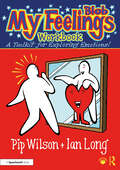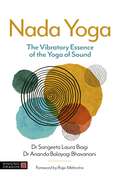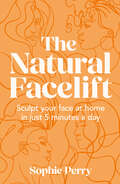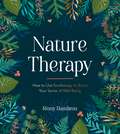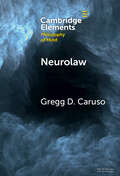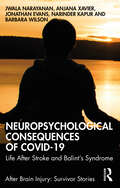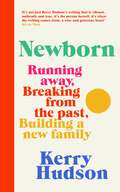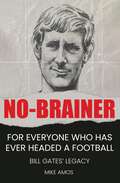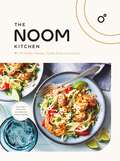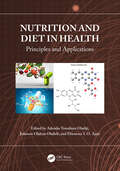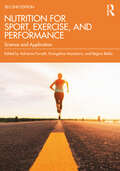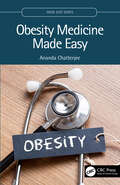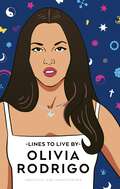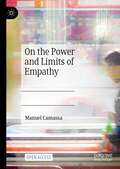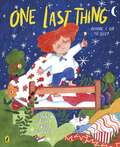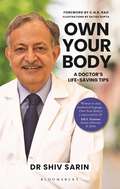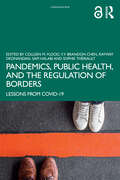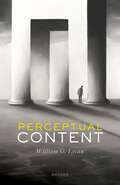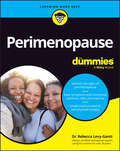- Table View
- List View
My Blob Feelings Workbook: A Toolkit for Exploring Emotions! (Blobs)
by Pip Wilson Ian LongMy Blob Feelings Workbook provides the reader with a series of unique visual reflective exercises that help to reveal one’s own emotional portrait. Using a combination of Blob characters and open questions, the reader can gradually build up an image of themselves across a wide range of ‘who I am’ subjects and real-life scenarios.Packed with well-loved blob illustrations, this book includes a wealth of downloadable pages and will enable the individual to ‘draw’ a picture of themselves emotionally through the series of exercises. Sections covered include: My Charts My Feeling Scales My Scenarios Myself Scales Best used as a personal toolkit for self-awareness, this book is also a rich resource for professionals working in the field of feelings to use with their own clients. It is suitable for all ages from secondary school upwards and ideal for individuals, couples, groups and all who wish to go deeper in understanding their emotional strengths and areas for development.
My Blob Feelings Workbook: A Toolkit for Exploring Emotions! (Blobs)
by Pip Wilson Ian LongMy Blob Feelings Workbook provides the reader with a series of unique visual reflective exercises that help to reveal one’s own emotional portrait. Using a combination of Blob characters and open questions, the reader can gradually build up an image of themselves across a wide range of ‘who I am’ subjects and real-life scenarios.Packed with well-loved blob illustrations, this book includes a wealth of downloadable pages and will enable the individual to ‘draw’ a picture of themselves emotionally through the series of exercises. Sections covered include: My Charts My Feeling Scales My Scenarios Myself Scales Best used as a personal toolkit for self-awareness, this book is also a rich resource for professionals working in the field of feelings to use with their own clients. It is suitable for all ages from secondary school upwards and ideal for individuals, couples, groups and all who wish to go deeper in understanding their emotional strengths and areas for development.
Nada Yoga: The Vibratory Essence of the Yoga of Sound
by Dr Sangeeta Biagi Ananda Balayogi BhavananiNada Yoga may be translated as the Yoga of Vibration and Sound. Its teachings are both ancient and applicable to our contemporary Yoga practice as they help refine our inner listening skills and support the healthy expression of our voice. This contemporary manual offers clarity and guidance on Nada Yoga and fuses traditional teachings with modern science in a multicultural and multimedia approach. Authored by an experienced and dynamic author duo who are well versed in yoga therapy, modern medicine, and music, Dr Ananda Balayogi Bhavanani and Dr Sangeeta Laura Biagi bring a variety of novel approaches and methodologies to help students understand the advanced meditative techniques required for Nada Yoga and the principles behind them.It will include a comprehensive overview of Nada Yoga, the Pranava AUM, the Chakras, Carnatic Music Essentials, Relaxation and Healing, and Yoga Therapy Applications.
The Natural Facelift: Sculpt Your Face At Home In Just 5 Minutes A Day
by Sophie PerryGive yourself the gift of an all-natural facelift from the comfort of your own home.
Nature Therapy: How to Use Ecotherapy to Boost Your Sense of Well-Being
by Rémy DambronNature therapy is the practice of reconnecting with the natural world to refresh your physical and mental well-being. Including tips to help you discover your connection with the outdoors, activity inspiration and a holistic approach to wellness, this book is the ultimate guide to unlocking the transformative power of nature.
Neurolaw (Elements in Philosophy of Mind)
by null Gregg D. CarusoNeurolaw is an area of interdisciplinary research on the meaning and implications of neuroscience for the law and legal practices. This Element addresses the potential contributions of neuroscience, and the brain sciences more generally, to criminal justice decision-making and policy. It distinguishes between three different areas and domains of investigation in neurolaw: assessment, intervention, and revision. The first concerns brain-based assessments, which may be used for predicting future violence, lie detection, judging legal insanity, and the like. The second concerns potential treatments and other interventions that aim at rehabilitating criminals and/or preventing crime before it occurs. The third investigates the ways that neuroscience may impact the law by changing or revising commonsense views about human nature and the causes of human action.
Neuropsychological Consequences of COVID-19: Life After Stroke and Balint's Syndrome (ISSN)
by Jwala Narayanan Anjana Xavier Jonathan Evans Narinder Kapur Barbara WilsonNeuropsychological Consequences of COVID-19 focuses on Anjana’s journey as a COVID survivor following a brain injury that left her with a very rare neuropsychological syndrome called Balint’s syndrome, a disorder associated with difficulties in visual and spatial coordination. It is also the first book of its kind to provide a first-hand account from India on surviving brain injury, from diagnosis, recovery and rehabilitation, providing the therapeutic milieu in the Indian context and exploring cultural influences on rehabilitation.Written jointly by Anjana, her neuropsychologist and the international experts in the field of neuropsychology who were also involved in her diagnosis and care, the book highlights how COVID-19, a virus primarily affecting the respiratory system, can also result in a disabling brain injury. It describes Anjana’s recovery and the rehabilitation she received and provides a deeper understanding of this experience of a very rare condition through the views of Anjana herself. In addition, Anjana’s rehabilitation journey stumbles upon many important themes of rehabilitation including cultural sensitivity, personal identity, resilience, role of family and rehabilitation in a low to middle income country.This book is valuable reading for clinical and neuropsychologists, neurologists, other rehabilitation therapists including physiotherapists, occupational therapists, nurses and social work professionals, particularly those interested in cross cultural rehabilitation. It will also be of interest to students in these fields.
Neuropsychological Consequences of COVID-19: Life After Stroke and Balint's Syndrome (ISSN)
by Jwala Narayanan Anjana Xavier Jonathan Evans Narinder Kapur Barbara WilsonNeuropsychological Consequences of COVID-19 focuses on Anjana’s journey as a COVID survivor following a brain injury that left her with a very rare neuropsychological syndrome called Balint’s syndrome, a disorder associated with difficulties in visual and spatial coordination. It is also the first book of its kind to provide a first-hand account from India on surviving brain injury, from diagnosis, recovery and rehabilitation, providing the therapeutic milieu in the Indian context and exploring cultural influences on rehabilitation.Written jointly by Anjana, her neuropsychologist and the international experts in the field of neuropsychology who were also involved in her diagnosis and care, the book highlights how COVID-19, a virus primarily affecting the respiratory system, can also result in a disabling brain injury. It describes Anjana’s recovery and the rehabilitation she received and provides a deeper understanding of this experience of a very rare condition through the views of Anjana herself. In addition, Anjana’s rehabilitation journey stumbles upon many important themes of rehabilitation including cultural sensitivity, personal identity, resilience, role of family and rehabilitation in a low to middle income country.This book is valuable reading for clinical and neuropsychologists, neurologists, other rehabilitation therapists including physiotherapists, occupational therapists, nurses and social work professionals, particularly those interested in cross cultural rehabilitation. It will also be of interest to students in these fields.
Newborn: Running Away, Breaking with the Past, Building a New Family
by Kerry Hudson‘It was always going to be difficult to follow Lowborn, but Kerry Hudson is Kerry Hudson and she has done it – cleverly, honestly, brilliantly’ RODDY DOYLE'Filled with colour: food, Prague, illness, love, the challenges of having a baby in a foreign country and making your own story' AMY LIPTROTIn Newborn, prizewinning writer Kerry Hudson navigates trying to build a nourishing, safe and loving family - without a blueprint to work fromKerry Hudson is celebrated for her emotionally and politically powerful writing about growing up in poverty. Her books and journalism have changed the conversation and touched countless lives.In this new book she asks: what next, after a childhood like hers? What hope is there of creating a different life for herself, let alone future generations? We see how Kerry found love, what it took to decide to start a family of her own and how fragile every step of the journey towards parenthood was. All along the way, she faces obstacles that would test the strongest foundations, from struggles with fertility to being locked down in a Prague maternity hospital to a marriage in crisis. But over and over again, her love, hope, fight -- and determination to break patterns and give her son a different life -- win through and light her path.Newborn is a beautiful, empowering memoir about creating a family in the midst of chaos, and learning new ways to find happiness. It continues the journey Kerry started in her bestselling memoir Lowborn, illuminating her experiences of becoming a mother, reshaping her future and reclaiming her identity.PRAISE FOR KERRY HUDSON:‘It’s not just Kerry Hudson’s writing that is vibrant, authentic and true, it’s the person herself, it’s where the writing comes from; a wise and generous heart’ KIT DE WAAL'Hudson’s resilience, grace and humility are staggering. She’s an absolute inspiration’ DOUGLAS STUART‘Kerry Hudson blew me away, opened my eyes’ PHILIPPA PERRY
No-brainer: A Footballer's Story of Life, Love and Brain Injury
by Mike Amos"A heart-breaking but still inspiring insight into the real-life impact of the biggest issue facing the world's biggest sport."Jeremy Wilson, Chief Sports Reporter, The Telegraph This is the story of the 'real' Bill Gates. A famous footballer, a successful millionaire and a global philanthropist. This is the story of an incredible man and his remarkable wife, who in his final years made a commitment to use his brain to save the next generation of football players. Bill was Britain's first £50 a week teenage superstar who played 333 games for Middlesbrough, where he was the PFA representative. He was the first entrepreneur/businessman to make sports shops the centre of high-street fashion. He was a philanthropist who travelled the world using football to change the lives of millions of children in over 100 countries. But in 2017 his life changed when he was diagnosed with football's best-kept secret, probable Chronic Traumatic Encephalopathy, caused by repetitive head impacts including headers, a brain disease with no cure. Author Mike Amos perfectly captures the incredible life of Bill and Judith, from a coal mining village in Ferryhill in the 1950s, a brilliant 13-year professional career in the 60s and 70s, a chain of sports shops in the 80s, to a millionaire's lifestyle on 7 mile beach on Grand Cayman in the 90s, to their most difficult journey together to ensure the future of the beautiful game. He shares Judith's work, designing the Billion Pound Game of Football that captured the attention of media around the globe and highlighted the need for changes in sport. Their ground-breaking Head Safe Football charity has led to research and education, and supported families of players with CTE. Designed to protect the future of the game, Head Safe Football educates players, coaches, sports scientists, and parents to recognise that CTE begins in young footballers and can be prevented with common sense Head Safe Football policies and training. No-Brainer explains how one man and his family have galvanised the football world around facts and science to impact player care and child safeguarding policies for both males and females. If you have ever headed a football, if your child or grandchild are heading footballs, then this is the one book that you need to read. Reviews "A heart-breaking but still inspiring insight into the real-life impact of the biggest issue facing the world's biggest sport. But does football care enough about its former heroes to take sufficient action?" Jeremy Wilson, Chief Sports Reporter, The Telegraph "What a brilliant read. Took me through every emotion from laughing and smiling to tears of true sadness. A great insight into the dark and oh so sad side of the beautiful game. A must-read, not only for the light-hearted reminiscing of football anecdotes and memories, but to learn the startling truth behind a game touching so many lives, and the devastation it can cause." Hilary Maddren, widow of Willie Maddren, Middlesbrough player and manager who died of neurodegenerative disease "Not just an important read for football fans, but for anyone whose life has been touched by the slowly unfolding despair of dementia." Harry Pearson, author of The Far Corner "No Brainer is a meticulous and moving read that exposes the cost of football's collective failure to protect players. One day, football will thank women like Dr Judith Gates who fought to spare future generations the pain they suffered as they watched their loved ones slowly succumb to diseases like CTE." Warren Manger, Daily Mirror "Bill and Judith Gates are the opposites who stayed attracted for more than 60 years together, but both in their very different ways have become titans in the world of football. This book is a vivid and vital account of their work together to improve the lives of footballers, young and old" Michael Aylwin, sportswriter, The Guardian
The Noom Kitchen: 100 Healthy, Delicious, Flexible Recipes for Every Day
by Noom Inc.The only official Noom cookbook! Easy, healthy, nutritious recipes for achieving your health goals deliciously!Noom is a global phenomenon-their digital health and weight management program has helped millions lose weight and feel better by focusing on the psychology of food and behavior change. The Noom Kitchen - follow-up to Noom's bestselling book The Noom Mindset -offers spectacularly delicious recipes that make serving health-forward foods easy for cooks of all skill levels. The majority of the recipes focus on using 'green foods', nutritionally dense ingredients that fill you up without weighing you down. With selections like Saucy Pizza-Stuffed Chicken Breast, Spinach & Feta 'Hot Pockets,' and Easy Strawberry Cheesecake Ice Cream, The Noom Kitchen applies Noom's trademark approach to nutrition to help readers:- Put a healthy twist on favorite foods like french fries, pizza, and dessert- Cook meals and snacks designed to be portable and storable so you can eat well on-the-go- Learn new techniques for boosting the nutrient density (and decreasing the caloric density) of any meal.These recipes will appeal to dedicated Noom users and new readers alike, providing accessible culinary guidance for anyone looking to kick-start their health and wellness in the kitchen.
Nutrition and Diet in Health: Principles and Applications
by Adenike Temidayo Oladiji Johnson Olaleye Oladele Ebenezer I. O. AjayiNutrition and diet play a crucial role in sustaining good health throughout human lives. Food provides us with essential nutrients involved in many physiological activities and biological processes in the body including growth and development, metabolism, immune function, and overall well-being. Nutrition and Diet in Health: Principles and Applications reviews and discusses the issues related to the roles of nutrition and diet in human health and diseases.The book contains two sections – one section features principles, the other, covers applications. Part I provides information on sustainable use of nutrition and diets in health and diseases; advanced biotechnological approaches to improve nutritional content of food; trace elements in nutrition; drug and nutrient interactions; functional foods and nutraceuticals in health maintenance; and biomarkers of functional foods and nutraceuticals in health maintenance. Part II discusses the significance of nutrition in selected human diseases, including cardiovascular diseases, cancer, infection, neurodegenerative diseases, and metabolic co-morbidities. It also discusses optimal nutrition for wellness, fitness, pregnancy, mental health, aging, and longevity.Features Molecular and cellular-based research findings on the principles and applications of nutrition and diet in health Roles of nutritional agents in the pathogenesis of human diseases Underlying mechanisms that govern activities and strategies to prevent pathological conditions using nutritional agents Nutrition and Diet in Health: Principles and Applications is suitable for academia and scientists, enhances knowledge of students in healthcare and areas of biological sciences.
Nutrition and Diet in Health: Principles and Applications
Nutrition and diet play a crucial role in sustaining good health throughout human lives. Food provides us with essential nutrients involved in many physiological activities and biological processes in the body including growth and development, metabolism, immune function, and overall well-being. Nutrition and Diet in Health: Principles and Applications reviews and discusses the issues related to the roles of nutrition and diet in human health and diseases.The book contains two sections – one section features principles, the other, covers applications. Part I provides information on sustainable use of nutrition and diets in health and diseases; advanced biotechnological approaches to improve nutritional content of food; trace elements in nutrition; drug and nutrient interactions; functional foods and nutraceuticals in health maintenance; and biomarkers of functional foods and nutraceuticals in health maintenance. Part II discusses the significance of nutrition in selected human diseases, including cardiovascular diseases, cancer, infection, neurodegenerative diseases, and metabolic co-morbidities. It also discusses optimal nutrition for wellness, fitness, pregnancy, mental health, aging, and longevity.Features Molecular and cellular-based research findings on the principles and applications of nutrition and diet in health Roles of nutritional agents in the pathogenesis of human diseases Underlying mechanisms that govern activities and strategies to prevent pathological conditions using nutritional agents Nutrition and Diet in Health: Principles and Applications is suitable for academia and scientists, enhances knowledge of students in healthcare and areas of biological sciences.
Nutrition for Sport, Exercise, and Performance: Science and Application
by Adrienne Forsyth Evangeline Mantzioris Regina BelskiNutrition for Sport, Exercise, and Performance offers a clear, practical, and accessible guide to building a comprehensive understanding of sport and exercise nutrition from leading experts in nutrition and exercise science. Nutrition before, during, and after training or a sporting event can improve the comfort, energy, and performance of athletes of all levels, from elite to recreational, as well as providing long-term health benefits. As such, nutrition is a key element of an athlete’s health and performance strategy, whether competing recreationally or at an elite level.Split into three parts, this new and revised edition of Nutrition for Sport, Exercise, and Performance provides an evidence-based introduction to nutrition for sport, exercise, and performance. Part I focusses on nutrition and sport science by explaining key principles underpinning sports nutrition science, including energy systems, exercise physiology and metabolism, and the digestion and absorption of macronutrients and micronutrients essential for performance and discusses factors influencing dietary intake, energy availability, and the process of dietary assessment. Part II is focussed on nutrition for exercise, pre- and post-training, hydration, supplements, and body composition measurement and modification. The final part (Part III) focusses on applied sports nutrition for a range of sports and athletes. This second edition delivers new insights into working with female athletes, occupational athletes, and athletes in contemporary sports including sport climbing, surfing, skateboarding, and breaking.Featuring contributions from a range of sport and exercise nutrition professionals with practical sports nutrition strategies and the latest evidence and practice guidelines, this is a core reference for undergraduate students, sports professionals, and aspiring athletes alike.
Nutrition for Sport, Exercise, and Performance: Science and Application
Nutrition for Sport, Exercise, and Performance offers a clear, practical, and accessible guide to building a comprehensive understanding of sport and exercise nutrition from leading experts in nutrition and exercise science. Nutrition before, during, and after training or a sporting event can improve the comfort, energy, and performance of athletes of all levels, from elite to recreational, as well as providing long-term health benefits. As such, nutrition is a key element of an athlete’s health and performance strategy, whether competing recreationally or at an elite level.Split into three parts, this new and revised edition of Nutrition for Sport, Exercise, and Performance provides an evidence-based introduction to nutrition for sport, exercise, and performance. Part I focusses on nutrition and sport science by explaining key principles underpinning sports nutrition science, including energy systems, exercise physiology and metabolism, and the digestion and absorption of macronutrients and micronutrients essential for performance and discusses factors influencing dietary intake, energy availability, and the process of dietary assessment. Part II is focussed on nutrition for exercise, pre- and post-training, hydration, supplements, and body composition measurement and modification. The final part (Part III) focusses on applied sports nutrition for a range of sports and athletes. This second edition delivers new insights into working with female athletes, occupational athletes, and athletes in contemporary sports including sport climbing, surfing, skateboarding, and breaking.Featuring contributions from a range of sport and exercise nutrition professionals with practical sports nutrition strategies and the latest evidence and practice guidelines, this is a core reference for undergraduate students, sports professionals, and aspiring athletes alike.
Obesity Medicine Made Easy
by Ananda ChatterjeeObesity is a complex disease, and this brief resource offers a comprehensive review of the most recent evidence on the multitude of ways to help treat this condition. Practically oriented for the reader to understand and easily apply the knowledge to patients, it specifically focuses on the lifestyle medicine approach to obesity management. This means applying the science of nutrition, movement, sleep, and stress with the help of cognitive behavioural therapy, motivational interviewing skills, positive psychology, and the circadian rhythm. This approach is combined with information on anti-obesity medications and bariatric surgery in a concise manner, immensely useful for the busy clinician. Key Features:• Captures the attention of the readers through a concise, lucid style of text and its organization.• Offers clarity on a common yet complex topic to physicians, dieticians, nurse practitioners and healthcare providers, leading to a change in practice and helping patients improve their weight which would impact underlying medical conditions.• Includes a comprehensive approach to management which combines the importance of medication, lifestyle habits and behavioural change.
Obesity Medicine Made Easy
by Ananda ChatterjeeObesity is a complex disease, and this brief resource offers a comprehensive review of the most recent evidence on the multitude of ways to help treat this condition. Practically oriented for the reader to understand and easily apply the knowledge to patients, it specifically focuses on the lifestyle medicine approach to obesity management. This means applying the science of nutrition, movement, sleep, and stress with the help of cognitive behavioural therapy, motivational interviewing skills, positive psychology, and the circadian rhythm. This approach is combined with information on anti-obesity medications and bariatric surgery in a concise manner, immensely useful for the busy clinician. Key Features:• Captures the attention of the readers through a concise, lucid style of text and its organization.• Offers clarity on a common yet complex topic to physicians, dieticians, nurse practitioners and healthcare providers, leading to a change in practice and helping patients improve their weight which would impact underlying medical conditions.• Includes a comprehensive approach to management which combines the importance of medication, lifestyle habits and behavioural change.
Olivia Rodrigo Lines to Live By
by Pop Press‘It’s fun to be playful and not take yourself too seriously.’Olivia Rodrigo has dominated the charts since bursting onto the scene with smash hits like Drivers Licence and Deja Vu and is loved for her raw and relatable lyrics.Ignoring Olivia's wisdom on growing up, feminism, relationships, and creativity would be a 'Bad Idea, Right?'
On the Power and Limits of Empathy
by Manuel CamassaThis book has two main objectives. The first is to identify and adequately describe the phenomenon of empathy. This essentially means offering a strong, reasoned and accurate description of the phenomenon of empathy in order to capture the essence of the empathic phenomenon and clearly distinguish it from other similar emotional phenomena such as sympathy or compassion The second part focuses on the role that this phenomenon can play on the ethical-moral level. The question is whether empathy is necessary or at least important for morality, and if so, to what extent, in what way and for what reasons. This is an open access book.
One Last Thing
by Natalia O’Hara"Daddy, please can I say one last thing?"Mattie is going to bed - she definitely is... She has just one more thing to say before she goes to sleep.However that one more thing turns out to be a fantastical adventure which guides Mattie and Daddy round the house in pursuit of the tricky, twisty Great Pampoose. But will Mattie ever get to bed?Celebrating imaginative play amidst the battle of bedtime, these awardwinning first-time collaborators bring to life a rich world of adventure at home.
Own Your Body: A Doctor's Life-saving Tips
by Dr. Shiv SarinDivided into six clear and easy to follow sections focusing on topics such as liver, Own Your Body bridges the gap between medical jargon and everyday life. Whether you're facing a health scare or just striving for a better lifestyle, Dr. Sarin's wisdom shines through, empowering readers to take charge of their health.
Pandemics, Public Health, and the Regulation of Borders: Lessons from COVID-19
This book examines how the COVID-19 pandemic has engendered a new and challenging environment in which borders drawn around people, places, and social structures have hardened and new ones have emerged.Over the course of the COVID-19 pandemic, borders closed or became unwelcoming at the international, national, sub-national, and local levels. Debate persists as to whether those countries and territories that tightly managed their borders, like New Zealand, Australia, or Hong Kong, got it ‘right’ compared to those that did not. Without doubt, a majority of those who suffered and died throughout the pandemic have been those from vulnerable populations. Yet on the other hand, efforts taken to manage the spread of the disease, such as through border management, have also disproportionately affected those who are most vulnerable. How then is the right balance to be struck, acknowledging, too, the economic and other imperatives that may dissuade governments from taking public health steps? This book considers how international organizations, countries, and institutions within those countries should conceive of, and manage, borders as the world continues to struggle with COVID-19 and prepares for the next pandemic. Engaging a range of international, and sub-national, examples, the book thematizes the main issues at stake in the control and management of borders in the interests of public health.This book will be of considerable interest to academics in the fields of health law, anthropology, economics, history, medicine, public health, and political science, as well as policymakers and public health planners at national and sub-national levels.
Pandemics, Public Health, and the Regulation of Borders: Lessons from COVID-19
by Colleen M. Flood Y.Y. Brandon Chen Raywat Deonandan Sam Halabi Sophie ThériaultThis book examines how the COVID-19 pandemic has engendered a new and challenging environment in which borders drawn around people, places, and social structures have hardened and new ones have emerged.Over the course of the COVID-19 pandemic, borders closed or became unwelcoming at the international, national, sub-national, and local levels. Debate persists as to whether those countries and territories that tightly managed their borders, like New Zealand, Australia, or Hong Kong, got it ‘right’ compared to those that did not. Without doubt, a majority of those who suffered and died throughout the pandemic have been those from vulnerable populations. Yet on the other hand, efforts taken to manage the spread of the disease, such as through border management, have also disproportionately affected those who are most vulnerable. How then is the right balance to be struck, acknowledging, too, the economic and other imperatives that may dissuade governments from taking public health steps? This book considers how international organizations, countries, and institutions within those countries should conceive of, and manage, borders as the world continues to struggle with COVID-19 and prepares for the next pandemic. Engaging a range of international, and sub-national, examples, the book thematizes the main issues at stake in the control and management of borders in the interests of public health.This book will be of considerable interest to academics in the fields of health law, anthropology, economics, history, medicine, public health, and political science, as well as policymakers and public health planners at national and sub-national levels.
Perceptual Content
by William G. LycanPerceptual Content is the first book to discuss and compare the representational characters of all the traditional "five senses". It has three main topics or concerns. (1) The diversity of the senses: though Lycan maintains as a working assumption that all perception represents, the similarity between sense modalities ends there. The senses' respective representational modes, styles and structures -- not just their mechanisms -- differ very strongly from each other. (2) The Layering thesis: Lycan argues that a single sensory representation usually has more than one content, the contents systematically related to each other by a priority or dependence relation. More specifically, a perceptual state may represent one object or property by representing a more primitive or less ambitious one; he calls this the "layering" of content. For example, by hearing a sound sequence involving such-and-such volumes and timbres, you hear a voice speaking, and by hearing the voice, you hear words in a language. In some modalities layering works unexpectedly: nearly all tactile representation derives from representation of conditions of or in the subject's own skin, meaning that touch represents, e.g., the texture of a physical object by, and only by, representing stress within the skin; and even among the skin conditions, some are represented only by representing more primitive ones. (3) Aspect perception: despite Wittgenstein's famous discussion of "seeing as" in a late section of Philosophical Investigations, little has been written on perceiving-as. Besides its intrinsic interest -- even popular appeal, what with joke ambiguous figures such as the duck-rabbit and the old/young woman -- it remains especially mysterious. Nearly all work on it has concerned vision only. But it is crucial for understanding auditory representation, which is one thing that distinguishes hearing from the other senses. Further, the auditory case severely damages what Lycan and others had thought was the best approach to understanding aspect perception, in terms of attention.
Perimenopause For Dummies
by Rebecca Levy-GanttGet to know perimenopause and manage troublesome symptoms Perimenopause For Dummies is a practical and comprehensive guide to the emotional, mental, and physical changes that begin to happen as you approach menopause. Demystify the connection between hormones and aging and make informed choices about how to deal with symptoms like weight gain, hot flashes, depression, mood swings, and insomnia. You’ll learn about natural remedies and medical interventions that can ease the transition between fertility and menopause. Most importantly, you’ll know what to expect, so the changes happening in your body won’t take you by surprise. This Dummies guide is like a trusted friend who can guide you through your life’s next chapter. Learn what perimenopause is and identify the most common symptoms Understand how perimenopause can affect your body, emotions, and libido Ease symptoms with hormonal solutions, diet, and exercise Discover ways of supporting yourself or your loved ones through perimenopausePerimenopause For Dummies offers clear, compassionate answers for anyone who is currently experiencing perimenopause or who is ready to learn more about it.
